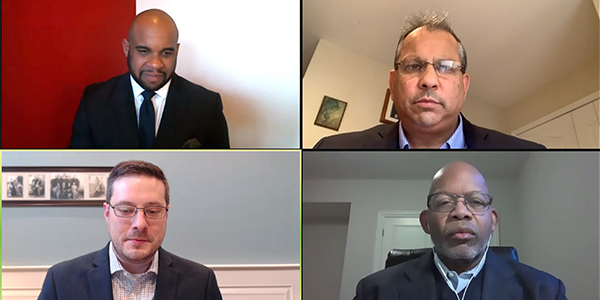Drones have the potential to revolutionize utilities’ information gathering and grid resilience, far outweighing the time and expense of adopting the new technology, according to speakers at the National Association of Regulatory Utility Commissioners’ Winter Policy Summit on Tuesday.
“This technology is a game changer. … The time and ease and even the cost [of inspection] is much improved using the [drone] technology at our disposal,” Duquesne Light Co. COO Kevin Walker told a panel on “Emerging Technologies for a Resilient Grid.”
Drones Capture ‘Impossible’ Shots
Duquesne has been using drones since 2018, and their benefits are already obvious, according to Walker. He described the unmanned aerial vehicles creating topographical maps of landslides to assist in recovery planning. The maps they develop can tell operators whether vehicles will be able to access the affected locations.
The utility has also sent drones on inspection trips into unstable tunnels where workers can’t be sent for fear of collapse, and to take photos of conduits on the underside of bridges that would be “nearly impossible to get with normal, conventional methods.”
The devices have become just as valuable in California, according to Andy Abranches, senior director of special projects at Pacific Gas and Electric. Abranches recalled the utility’s efforts to inspect the entire transmission system in the wake of 2018’s Camp Fire, which investors said began with equipment that PG&E had made little effort to inspect and repair for nearly 90 years. (See “Reduced Inspections,” Ancient C Hook, Financial Manipulation Caused Camp Fire.)
To aid in the massive inspection effort, PG&E turned to aerial photography from both helicopters and drones. This gave inspectors a wealth of information, which turned out to create its own problems.
“The field of view and the angles that you get from using helicopter aerials, as well as drones, really enriches the inspection process. But all of that comes at a pretty significant cost [of] a huge volume of inspection photos,” Abranches said. “Just in a two-year period, we got over 4 million inspection photos … and [when] we have someone in the back office … reviewing that information, [it’s] very cumbersome.”
Humans Always Needed
PG&E’s solution was an internal project called the Sherlock Suite, which combines a repository for images with a set of models designed to automatically sort them into searchable categories. Similar images can be grouped together for mass inspection, and pictures of a particular location can also be viewed on a timeline so that when a problem is found, inspectors can cycle back through earlier photos to discover when it first emerged.
Building this tool has taken more than two years, and while Abranches said the team has made a strong product, “training” the artificial intelligence to recognize and sort the images reliably is likely to take far longer. The Sherlock Suite is expected to improve over time thanks to its machine-learning capabilities, but panelists agreed that humans always need to be in the loop. Ideally, the system’s organic and technological components will build on each other’s strengths.
“Any superpower can be overplayed. … Nothing can be 100% accurate all the time, and there [are] embedded biases … in our technology,” Walker said. “So we have to create that check and balance. … That’s why we have people like data scientists coming into our industry in more numbers than we ever have before, because they know how to analyze that data and [detect] anomalies that the naked eye … can’t see.”
Asked about security for these databases — which could include images of people who were unaware their pictures were being taken — participants acknowledged that this issue has to be a priority. Drew McGuire, senior program manager of distribution for the Electric Power Research Institute, recommended that planners follow their instincts for caution and never assume any system is invulnerable.
“When we design a system, when we design a distribution line, we don’t know exactly what’s going to happen … but we know eventually this line will be stressed,” McGuire said. “We can think of cyber in kind of a similar approach. We may not know the exact vector that’s going to be used … [but] eventually there’s a potential that they’re going to be stressed. And we need to … design them in that kind of way, where you assume that at some point you’re going to have to respond and react.”






